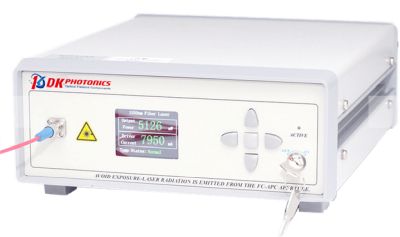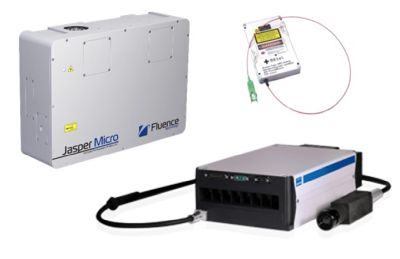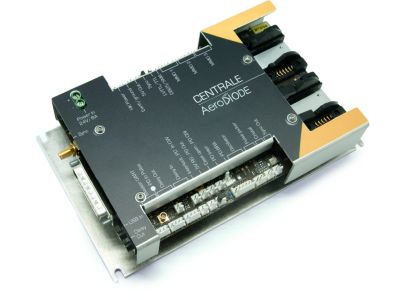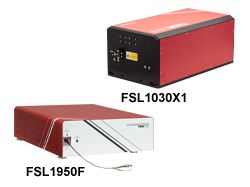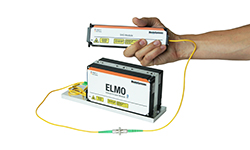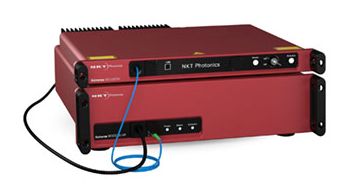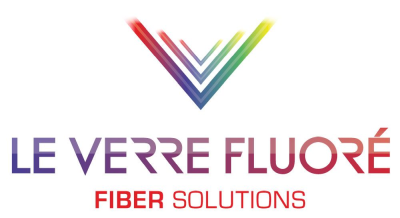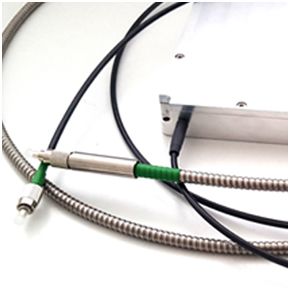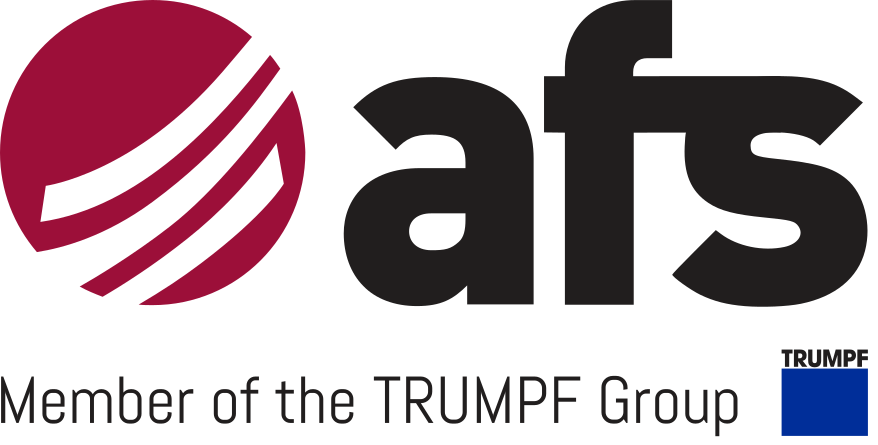fiber lasers versus bulk lasers (original) (raw)
Definition: Fiber lasers are based on fiber waveguides, while bulk lasers are based on bulk laser crystals.
Categories:  fiber optics and waveguides,
fiber optics and waveguides,  laser devices and laser physics
laser devices and laser physics
Page views in 12 months: 950
DOI: 10.61835/edr Cite the article: BibTex plain textHTML Link to this page! LinkedIn
For purchasing fiber lasers, use the RP Photonics Buyer's Guide – an expert-curated directory for finding all relevant suppliers, which also offers advanced purchasing assistance.
Contents
It is natural to compare different laser concepts with each other, in particular when they are used in overlapping application areas. This is particularly the case for two different kinds of solid-state lasers: bulk lasers and fiber lasers. There have been claims that fiber lasers, which have shown tremendous progress in recent years, will eventually replace most bulk lasers, since they could reach the same or better performance at a lower price. However, it is then overlooked that they also face a number of challenges, and depending on the specific goals these may outweigh the advantages. The outcome of such a comparison can thus depend strongly on various details of the specific requirements.
In recent years, global fiber lasers sales showed a significantly stronger growth than those of traditional solid-state lasers. In the area of laser material processing (including areas like laser marking and micro material processing), in 2020 they have already reached a market share around 50%. Less important application areas are in the military domain, fiber-optic sensors and medical lasers.
Technical Challenges of Fiber and Bulk Laser Devices
In the following, the most important aspects are briefly illuminated to permit a fair comparison of the concepts.
Basic Laser and Optical Properties
The moderate gain and pump absorption per unit length of rare-earth-doped fibers, caused by limitations to the doping concentration in glasses, requires the use of relatively long gain media, which has various consequences, as discussed below.
The long length and small effective mode area of fiber lasers lead to strong effects of the Kerr nonlinearity, despite the relatively small nonlinear index of fused silica (the most popular glass material for fibers). Particularly in the context of ultrashort pulse generation, but also for single-frequency lasers and amplifiers, excessive nonlinearity can have very detrimental effects. It often limits the achievable pulse duration or output power.
Most fiber lasers operate with high gain and high resonator losses. This makes them relatively immune to additional losses e.g. from various types of intracavity components. For example, a fiber laser resonator may well contain a grating pair for wavelength tuning without the efficiency being degraded too much by the introduced resonator losses. On the other hand, the small resonator losses of many bulk lasers make those more interesting for intracavity frequency doubling and can lead to lower phase noise.
Many fiber devices are subject to problems with uncontrolled birefringence. It is not only that this often changes the polarization state from linear to elliptical; these changes are unfortunately dependent on temperature and bending. Many fiber lasers therefore may require readjustment of polarization controllers when the temperature changes. This may be acceptable for laboratory use, but often not for commercial devices. One does not always have the option to eliminate such problems by using polarization-maintaining fibers, since special fibers and fiber devices are often not available in this form, and e.g. mode locking with nonlinear polarization rotation would not work with a polarization-maintaining fiber.
Aspects Concerning High-power Devices
Both fiber and bulk lasers can generate multi-kilowatt powers. The power conversion efficiency (wall-plug efficiency) of fiber devices can be very high, and is often significantly better than that of bulk lasers. On the other hand, fiber devices require pump sources with a higher beam quality and brightness, compared with pump diodes for bulk lasers, generally increasing the price per watt of the pump source.
The geometry of fibers and their built-in waveguide effect essentially eliminate disturbing thermal effects (such as thermal lensing) and thus make it possible to achieve an excellent beam quality even at very high power levels. This is generally more difficult with bulk lasers, but some bulk laser concepts (in particular that of the thin-disk laser) have the potential for even higher single-mode powers.
Optical nonlinearities can limit the performance of high-power fiber devices in various ways, particularly in the context of pulse generation. A hard peak power limit in pulsed fiber devices is introduced by nonlinear self-focusing. The Raman effect is also strong in fibers and can be a limiting factor also for high-power continuous-wave fiber lasers. In single-frequency operation, stimulated Brillouin scattering introduces severe limitations. All these limits are much less severe for bulk laser devices, where nonlinearities can be weaker by orders of magnitude.
Short Pulse Generation
Both fiber and bulk lasers can be Q-switched for generating nanosecond pulses. The shortest pulse durations are usually achieved with bulk lasers, as the gain per unit length is smaller for fiber devices. Also, fiber devices are limited in terms of peak power (see above).
High-power nanosecond laser systems based on fibers often contain some seed laser and a fiber amplifier, allowing for very high average power while still being limited in terms of peak power. In principle, very short seed pulses could be amplified, but the seed pulses often have to be made long enough to keep the peak power sufficiently low.
Ultrashort Pulse Generation
Fiber lasers are based on rare-earth-doped glass fibers, which offer a high amplification bandwidth compared with rare-earth-doped laser crystals. The fiber format allows the use of glasses without suffering from their lower thermal conductivity (because of the geometry and the waveguide effect) and their typically lower laser cross-sections (because of the ease of obtaining a high gain in a fiber). As a result, fiber lasers can have very broad wavelength tunability and can generate very short optical pulses via passive mode locking. However, mode-locked fiber lasers often cannot utilize the full potential of the gain bandwidth in terms of pulse duration because of the detrimental effects of excessive nonlinearities and higher-order chromatic dispersion.
Fiber lasers can be mode-locked using nonlinear polarization rotation, which is an effective technique and less critical than additive-pulse mode locking of bulk lasers. However, such lasers are usually not long-term stable due to thermal variations of the birefringence (see above).
For fiber lasers with high (multi-gigahertz) pulse repetition rates, one usually requires the technique of harmonic mode locking, which makes the laser setup significantly more complicated than that of a compact bulk laser.
Sensitivity to Optical Feedback
High-power fiber devices for material processing are often very sensitive to optical feedback. One reason is that such devices are often master oscillator power amplifiers, so that the backreflected light is even amplified on its way back to the seed laser. In addition, the effective mode area is fairly small, so that fiber ends are easily destroyed. It is possible to use a Faraday isolator for preventing backreflected light from reaching the fiber, but this is not always practical, particularly at high power levels.
In many cases, one does not use an optical isolator, and then has to ensure that back-reflections are avoided e.g. by never allowing for normal incidence on a workpiece. This, however, can restrict the flexibility and possibly the processing quality.
Robustness and Cost
Simple fiber laser setups can be made from relatively cheap components, and they need fewer mechanical components. Ideally, a fiber laser setup should be made with fibers only, not involving any air space. Where this is possible, and processes such as fusion splicing of fiber components can be largely automated, fiber lasers can be significantly cheaper and smaller than bulk lasers. The output may then conveniently be delivered to a fiber connector, which allows easy connection to other devices without any alignment procedures.
However, the use of air spaces in fiber laser resonators often cannot be avoided, e.g. when certain bulk optical elements need to be inserted into the laser resonator, or fibers with very different mode areas are used and tapered fibers for mode area adaptation are not available. In such cases, the tight alignment tolerance of single-mode fibers and sometimes the high optical intensities at fiber ends may make the setup less robust than that of a bulk laser, and the cost may also not be low.
Maintenance is often not required by fiber devices. In the case of a defect, however, an all-fiber setup can make it relatively difficult to locate and exchange the defect part. On the other hand, it is easy to exchange fiber-optic components if fiber connectors are used.
The cost for developing a fiber-based laser system is often higher (as discussed in a Photonics Spotlight article), and the required time is longer. This is partly because it can be difficult to procure special parts, and sometimes (particularly for ultrafast lasers) because the operation principles of fiber lasers are more complicated than those of bulk lasers. Also, it is easier to combine different components in a bulk-optical setup, or to insert or remove parts for diagnostic reasons.
Uncertainties in Parameters
During the development of a laser system, difficulties can arise if relevant parameters of the gain medium are not known precisely.
For laser crystals as used in a bulk laser, there is a limited set of parameters such as doping concentration, spectroscopic data and geometrical parameters. For common crystal materials, the uncertainties are usually small, whereas spectroscopic data are often uncertain for less common materials.
For rare-earth-doped fibers, the situation is generally less satisfactory. A first reason is that a fiber consists of glass material where the composition is less well defined. Even the manufacturer may not know exactly the amount of germanium in the core of a germanosilicate fiber, for example, and often the exact composition is at least not revealed to customers. In addition, a fiber has additional parameters such as the core diameter or refractive index profile which can be uncertain and vary between different samples.
Some Guidelines
Some general guidelines for determining in which areas fiber lasers or bulk lasers may be stronger are as follows:
- Fiber lasers are suitable for generating very high average powers with high beam quality. This holds particularly for unusual wavelengths, where no good bulk crystals or glasses are available. Fiber lasers are clearly superior for difficult lasing schemes such as low-gain transitions or upconversion. However, bulk lasers are required for some other spectral regions; for example, there is no fiber laser to replace a broadly tunable Ti:sapphire laser in the region of 700–1000 nm.
- Bulk lasers have a higher potential for high pulse energies and peak powers either with Q switching or with mode locking.
- Bulk lasers can utilize pump sources with very poor beam quality. In the most extreme case, a side-pumped rod laser can be pumped with discharge lamps. That can be advantageous e.g. when very high peak powers in pulses with moderate repetition rates are required.
- Bulk lasers are often preferable when a stable linear polarization is required (and polarization-maintaining fibers can not be used for some reason).
- For ultrashort pulse generation, bulk lasers make it easier to achieve a high peak power and a high pulse quality in terms of smooth spectral shape, low chirp and low background.
- In terms of fabrication cost, fiber lasers will often be superior for devices with low demands on peak power, polarization, emission bandwidth, pulse quality, etc. However, more stringent demands of such type can often favor a bulk laser, as a fiber device would require complicated additional measures or very special parts. Also, the often higher development cost of fiber-based devices can be a problem in cases with small sales numbers.
The points discussed show clearly that both bulk and fiber lasers have significant advantages and disadvantages, so that one or the other concept can be superior depending on the particular circumstances.
Related Articles
Suppliers
The RP Photonics Buyer's Guide contains 141 suppliers for fiber lasers. Among them:
n2-Photonics
We present our turn-key Lamiks laser system integrated in one box:
- Pulse duration: <100 fs; <50 fs and <10 fs
- Power: up to 300 W
- Energy: 10 μJ and up to 3 mJ
- Repetition rate: up to 100 MHz
- Wavelength: 1030 nm
DK Photonics
DK Photonics offers various kinds of fiber lasers:
- lasers which are tunable over the C-band or L-band
- ultra-narrow linewidth lasers emitting at 1550 nm
- nanosecond pulsed fiber lasers emitting at 1550 nm
RPMC Lasers
Serving North America, RPMC Lasers offers a wide range of pulsed and CW fiber lasers deliver high efficiency and robust, low-maintenance designs in compact, customizable packages with flexible integration for industrial, scientific, and defense applications.
Pulsed fiber lasers provide high brightness, maximized absorption, and durability in harsh conditions, with low SWaP compensators and attenuators for handheld or airborne use, plus fundamental wavelengths to 5th harmonics for material-specific tasks across diverse markets.
CW fiber lasers offer NIR-SWIR wavelengths from 1060 nm to 2050 nm, including “eye-safe” 1.5 µm, with 150 mW – 1200 W outputs, single-mode, PM, and broadband options, plus OEM/turnkey configs with modulation, narrow linewidth, and power tunability for LIDAR, metrology, and processing.
Let RPMC help you find the right laser today!
Cycle
Cycle supplies fiber-based systems with unique features and affordable prices:
- Cycle’s SONATA is a SESAM-free, all-PM, low-noise fiber laser with high environmental stability. It provides a dual fiber/free-space outputs at 1030 nm with clean and low-noise pulses. A chirped picosecond pulse is coming from fiber port for amplification and a second compressed free-space output allows detection and stabilization – ideal for ultrafast applications, amplifier seeding, and nonlinear microscopy. With optics and electronics integrated into a single compact unit, SONATA ensures a seamless, plug-and-play experience.
- The SOPRANO-CA is designed to carry out tasks such as multiphoton microscopy, spectroscopy, semiconductor testing and materials analysis. In addition to its low relative intensity noise, reliability and clean pulse shape, the SOPRANO-CA operates at a center wavelength of 1560 nm and typical pulse duration below 150 fs, establishing benefits in both industrial and scientific environments.
AeroDIODE
AeroDIODE offers several tools to build a fiber laser efficiently and rapidly. Our fiber laser diode driver integrates two laser diode drivers, 6 photodiode electronics, a pulse picker synchronization tool and many other dedicated functionalities for nearly any type of fiber laser architecture. It allows to develop a complete fiber laser prototype in only a few weeks. There is one “pulsed & CW” channel for seed laser diode emitting at wavelength like 1064 nm laser diodes and one “CW” channel for a pump laser diode at 976 nm. It is connected to other drivers in our range like our air cooled high power laser diode driver for >10–200 W pump laser diodes or our pulse delay generator. It is compatible with any type of fiber laser architectures: mode-locked, Q-switched, MOPA with any type of seeder like EOM modulated diodes, gain-switched diodes, microchip lasers etc.
See also our tutorial on fiber laser basics.
O-E Land
O/E Land’s high-power continuous-wave fiber laser sources are available in a wide spectral range from 1 to ~3 μm. Based on our advanced optical technologies, they feature stable single-mode operation output up to 50 W optical power. They can be used in various applications including, but not limited to, medical, spectroscopy, sensing and R&D. We also offer narrow-linewidth lasers and Raman lasers.
Thorlabs
Thorlabs manufactures a growing line of femtosecond fiber lasers and amplifiers, including stand-alone systems at 1030 nm, 1550 nm, and 2 µm, as well as all-fiber mid-IR and long-wave IR supercontinuum lasers. These systems complement our full line of ultrafast lasers and specialized optics and fiber optics, including chirped mirrors, low GDD mirrors/beamsplitters, highly nonlinear fiber, and dispersion compensating fiber.
MPB Communications
MPBC’s fiber laser product line has grown out of its highly reliable telecom Raman fiber lasers, which have been deployed for 25+ years in telecom fiber optic systems.
Exceptional performance is achieved based on an all-fiber architecture, which draws on MPBC’s telecom design practices. The all-fiber laser design eliminates the need for alignment, as no bulk components are used. It provides unprecedented wavelength and output power stability and ensures a diffraction-limited linearly polarized output.
With wavelengths ranging from 465 nm to 2000 nm, MPBC's fiber laser product line includes CW visible to near-IR lasers, sub-nanosecond pulsed fiber lasers, ultrafast lasers, and single-frequency fiber lasers and amplifiers.
CNI Laser
CNI offers various types of fiber lasers: picosecond fiber lasers, nanosecond fiber lasers, single-frequency fiber lasers and CW fiber lasers. Output wavelengths can be from the ultraviolet region to the infrared.
FYLA LASER
At FYLA we develop ultrafast fiber lasers with pulse durations in the range of picoseconds and femtoseconds. Our lasers are used in a lot of applications, from microscopy (single-molecule fluorescence, OCT, FRET, TIRF, etc.) up to optical characterization, providing a greater level of robustness, higher lifetimes, and a cost-effective solution.
TOPTICA Photonics
TOPTICA offers several products fulfilling these requirements: ultrafast fiber lasers based on Erbium (Er) and Ytterbium (Yb) like the FemtoFiber smart, FemtoFiber ultra and FemtoFiber dichro series.
TOPTICA’s FemtoFiber lasers provide reliable femtosecond / picoseconds pulses based on polarization-maintaining fibers and SAM mode-locking. Different models (1560/780 nm, VIS/NIR tunable output, IR/NIR supercontinuum, short-pulse) cover a wide range of applications, e.g. non-linear microscopy, two-photon polymerization, time-domain Terahertz, attoscience, and as seed lasers.
A breakthrough for modern microscopy, FemtoFiber ultra FD eliminates free-space laser paths by replacing them with a simple FC/APC fiber connection. It ensures top performance with a 2-meter polarization-maintaining hollow-core fiber and stable coupling via TOPTICA’s FiberDock. The integrated AOM and GDD preservation deliver short, clean pulses with high spatial beam quality and watt-level power, making it ideal for 2-photon imaging. This fully turn-key solution enhances usability, safety, and image quality.
GWU-Lasertechnik
GWU offers versatile fiber lasers with single-mode linewidth, highest stability and low noise. They are scalable in power, customizable in wavelength and designed for reliable operation and industrial use. Tailored fiber lasers, fiber amplifiers, ASE sources and transport fibers will help to get the best out of your application.
Menlo Systems
Menlo Systems' femtosecond fiber lasers based on Menlo figure 9® patented laser technology are unique in regard to user-friendliness and robustness. We offer solutions for scientific research as well as laser models engineered for OEM integration. From the shortest pulses to highest average power beyond 10 Watts and pulse energy beyond 10 μJ, we have the solution for your application ranging from basic research to industrial applications in spectroscopy, quality control, and material processing.
Lumibird
Lumibird manufactures an extensive range of mature and custom-designed optical fiber amplifiers and fiber lasers. High output powers are achieved through the use of double cladding fibers pumped by broad stripe diodes. Several varieties of pumping techniques are used each optimized for specific applications. Lumibird also develops key components for producing unique and innovative light sources.
AdValue Photonics
AdValue Photonics produces various kinds of fiber lasers emitting in the wavelength regions around 1 μm, 1.5 μm and 2 μm. Continuous-wave and pulsed devices (with pulse durations in the nanosecond, picosecond or femtosecond regime) are available, partly with high peak power, high pulse energy, high beam quality, and narrow linewidth capabilities.
See also our overview on fiber laser products!
LumIR Lasers
LumIR offers mid-IR fiber lasers, based on fluorine glass fibers, with up to 10 W output power and emission wavelength between 2.79 μm and 3.3 μm. They are ideal for medical, material processing and sensing applications.
NKT Photonics
Optical fibers are at the heart of everything we do. We embed as many functions as possible directly into the fibers to make systems based on them simpler, cheaper, and more reliable. We base our fiber lasers on our own optical fibers. We offer several advanced laser platforms:
- SuperK supercontinuum white light laser platform
- Koheras single-frequency fiber laser platform
- aeroPULSE femtosecond laser platform
Our fiber lasers are robust and reliable, designed as fully integrated systems suitable for both industrial and scientific applications.
Le Verre Fluore
Based on our active fluoride fibers, we develop fiber modules that are easy to handle and directly integrable in a final commercial laser system.
We develop together with COPL Laval University, mid-infrared fiber lasers which are commercialized by our sister company LumIR Lasers. These fibers laser are, for example, used in medical applications.
Active Fiber Systems
AFS’s customized kW average power and multi-mJ pulse energy ultrafast laser systems are based on AFS leading-edge fiber technology. They unite multiple main-amplifier channels using coherent combination, a technology which AFS has matured to an industrial grade. All essential parameters are software-controlled and can be tuned over a wide range, making them an extremely valuable tool for numerous application.
HÜBNER Photonics
HÜBNER Photonics offers fiber lasers from the VALO Series. These are unique in their design offering among the shortest femtosecond pulses and highest peak powers which can be obtained from a compact turn-key solution. Pulse durations of <50 fs are achieved using novel fiber laser based technology. The ultrashort pulse durations combined with computer controlled group velocity dispersion pre-compensation, allow users of the VALO lasers to achieve the highest peak power exactly where its needed, which makes the lasers ideal for use in multiphoton imaging, advanced spectroscopy and many other applications.
- <50 fs pulse duration
- up to 2 W output power
- very low noise
- integrated pre-compensation dispersion module
Questions and Comments from Users
Here you can submit questions and comments. As far as they get accepted by the author, they will appear above this paragraph together with the author’s answer. The author will decide on acceptance based on certain criteria. Essentially, the issue must be of sufficiently broad interest.
Please do not enter personal data here. (See also our privacy declaration.) If you wish to receive personal feedback or consultancy from the author, please contact him, e.g. via e-mail.
By submitting the information, you give your consent to the potential publication of your inputs on our website according to our rules. (If you later retract your consent, we will delete those inputs.) As your inputs are first reviewed by the author, they may be published with some delay.


